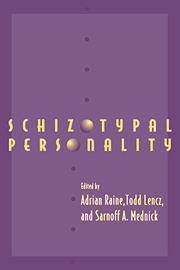Book contents
- Frontmatter
- Contents
- List of contributors
- Preface
- Acknowledgments
- Part I Introduction
- Part II Genetics and neurodevelopment
- Part III Assessment
- Part IV Categorical versus dimensional approaches
- 7 Tracking the taxon: on the latent structure and base rate of schizotypy
- 8 Detection of a latent taxon of individuals at risk for schizophrenia-spectrum disorders
- 9 Fully and quasi-dimensional constructions of schizotypy
- Part V Psychophysiology and psychopharmacology
- Part VI Neuropsychology
- Part VII Brain imaging
- Part VIII Conclusion
- Part IX Appendix
- Name Index
- Subject Index
9 - Fully and quasi-dimensional constructions of schizotypy
from Part IV - Categorical versus dimensional approaches
Published online by Cambridge University Press: 04 August 2010
- Frontmatter
- Contents
- List of contributors
- Preface
- Acknowledgments
- Part I Introduction
- Part II Genetics and neurodevelopment
- Part III Assessment
- Part IV Categorical versus dimensional approaches
- 7 Tracking the taxon: on the latent structure and base rate of schizotypy
- 8 Detection of a latent taxon of individuals at risk for schizophrenia-spectrum disorders
- 9 Fully and quasi-dimensional constructions of schizotypy
- Part V Psychophysiology and psychopharmacology
- Part VI Neuropsychology
- Part VII Brain imaging
- Part VIII Conclusion
- Part IX Appendix
- Name Index
- Subject Index
Summary
Two related themes run through this chapter. As the title indicates, one concerns the dimensionality inherent in our attempts to describe and understand schizotypy and schizotypal personality disorder (SPD). Although widely applied – and virtually definitive of the psychiatric notion of “borderline” – the concept of dimensionality is not entirely unambiguous, and constructions of it have varied. This is especially true where, as in the present case, attempts have been made to find a meeting point between ideas originating in the field of normal personality and other individual differences and those rooted more in psychiatry and clinical psychology. Here we explore some of the issues about dimensionality and suggest a preference for how it might best be applied to SPD; based upon our interpretation of the available evidence.
The second theme in the chapter is not unconnected to the above. It concerns attempts that are currently being made to discover experimental paradigms that can characterize the cognitive functioning of schizotypal and schizotypally disordered individuals; or, in another context, develop “markers” of a cognitive nature that might be helpful in high-risk and genetics research. Here it should be noted that the cognitive approach has no particular prerogative in either respect. Indeed it could be argued – and in our view probably is the case – that for many purposes the more promising lines of research are biological, especially neurodevelopmental. But the cognitive perspective does have significant claim on our attention, for two reasons. First, and most obviously, it allows us to probe the more purely psychological aspects of schizotypy; these are of interest in their own right, even though investigating them in the laboratory can be problematical.
Keywords
- Type
- Chapter
- Information
- Schizotypal Personality , pp. 192 - 216Publisher: Cambridge University PressPrint publication year: 1995
- 65
- Cited by



